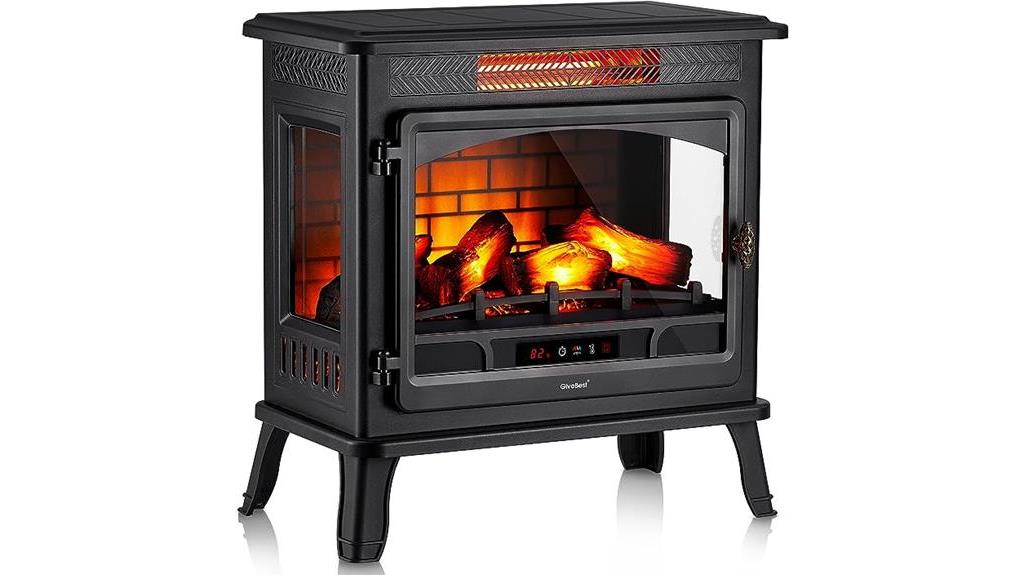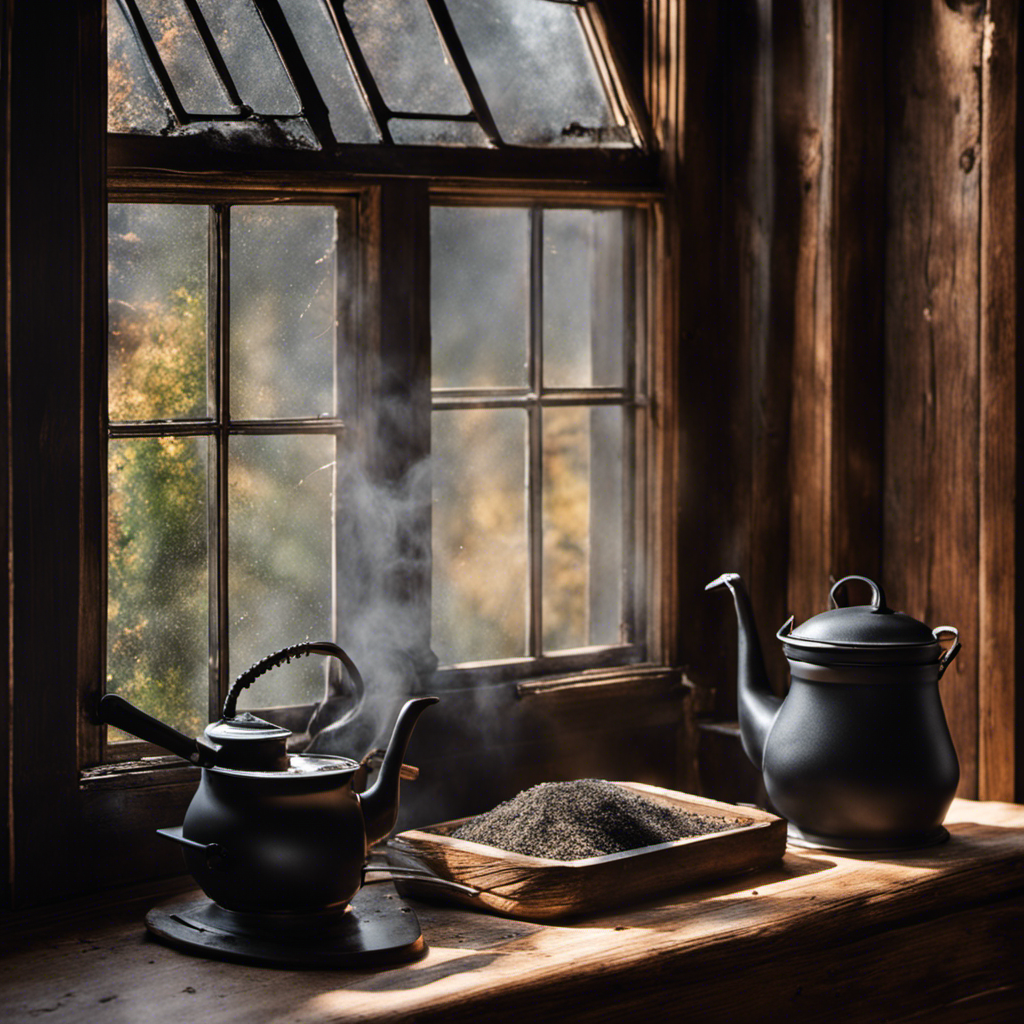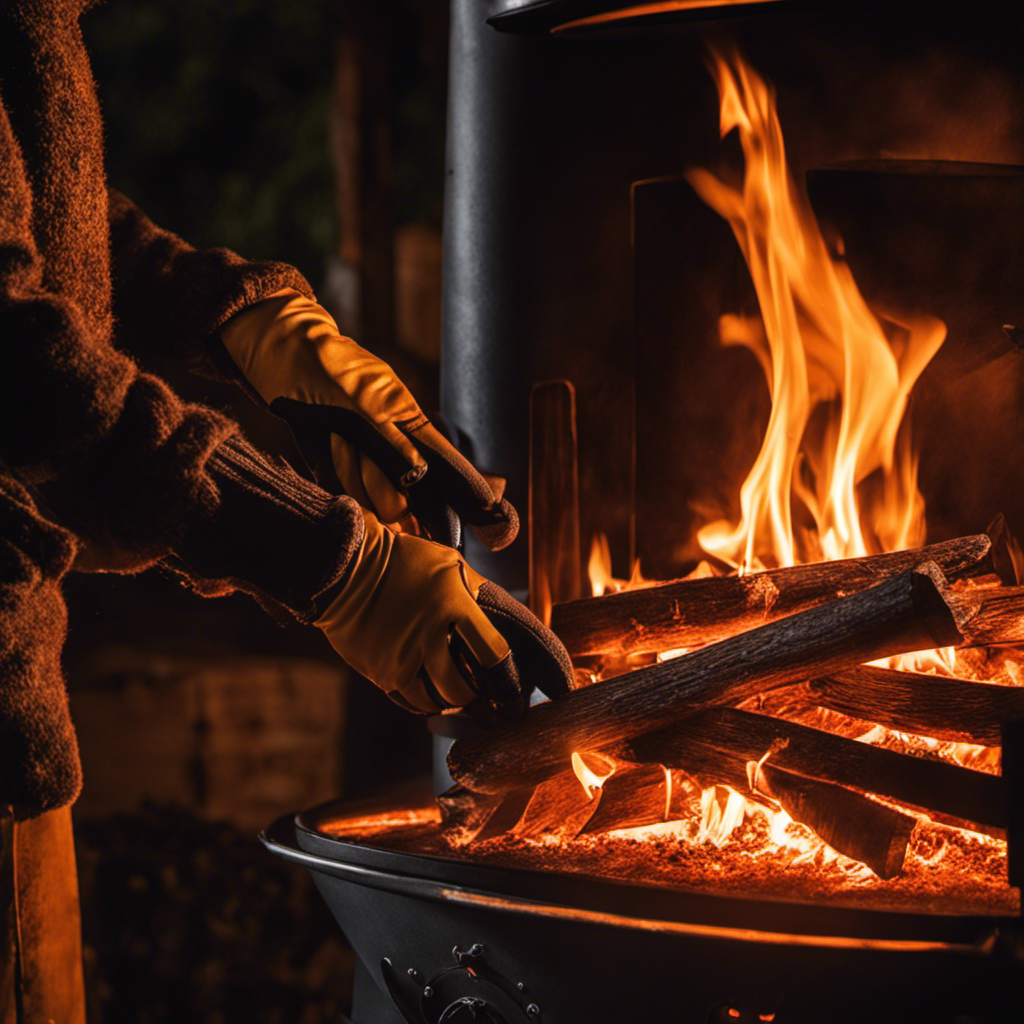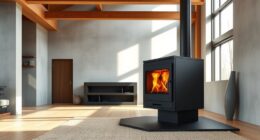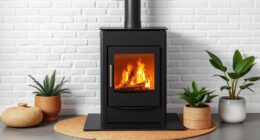Envision inhaling crisp, pure air that rejuvenates your lungs with each breath you take. Now, imagine this very same invigorating air flowing throughout your house, courtesy of your wood stove.
In this article, I’ll guide you through the steps to achieve just that. By understanding the impact of wood stove emissions, choosing the right wood, ensuring proper ventilation, and implementing supplemental air purification methods, you can transform your indoor environment into a haven of fresh, pure air.
Let’s embark on this journey together towards cleaner air from your wood stove.
Key Takeaways
- Wood stove emissions contain pollutants that contribute to air pollution, smog formation, and climate change.
- Using well-seasoned hardwoods like oak, maple, and birch can result in cleaner burning and reduced emissions.
- Proper ventilation, whether through natural or mechanical means, is essential for maintaining clean indoor air.
- Regular maintenance and cleaning of the wood stove and chimney are crucial for improving air quality in the home.
Understanding the Impact of Wood Stove Emissions
I can’t ignore the significance of understanding the impact of wood stove emissions on air quality. It’s crucial to delve into this topic in order to comprehend the adverse effects these emissions can have on the environment and our health.
Wood stove emissions are composed of various pollutants such as particulate matter, carbon monoxide, nitrogen oxides, and volatile organic compounds. These pollutants can contribute to air pollution, smog formation, and climate change.
Research has shown that exposure to wood stove emissions can lead to respiratory problems, cardiovascular issues, and even cancer. Therefore, it’s imperative to find ways to reduce the environmental impact of wood stove emissions, such as using cleaner burning stoves, properly maintaining and operating wood stoves, and promoting the use of alternative heating sources.
Choosing the Right Wood for a Cleaner Burn
To achieve a cleaner burn, it’s important to choose the right wood and use it properly in a wood stove. When it comes to choosing sustainable wood, there are a few key factors to consider:
-
Moisture content:
-
Opt for well-seasoned wood with a moisture content of around 20%. Higher moisture content leads to lower combustion efficiency and increased emissions.
-
Avoid wet or green wood as it can produce more smoke and creosote buildup.
-
Wood type:
-
Hardwoods like oak, maple, and birch are dense and burn longer, providing more heat with less smoke.
-
Softwoods like pine and spruce ignite quickly but burn faster, producing more smoke and creosote.
Proper Ventilation and Airflow for Clean Indoor Air
Having proper ventilation and airflow is crucial for ensuring clean indoor air, as it helps to remove pollutants and maintain a healthy living environment. Ventilation techniques play a significant role in air quality management by controlling the movement of air and removing contaminants.
One effective technique is natural ventilation, which relies on openings such as windows and doors to allow fresh air to enter and stale air to leave. Mechanical ventilation, on the other hand, utilizes fans and ducts to circulate air and remove pollutants.
Both techniques can be enhanced with the use of air filters, which trap airborne particles and improve indoor air quality. It’s important to regularly maintain and clean ventilation systems to ensure their optimal performance.
Maintaining and Cleaning Your Wood Stove for Better Air Quality
Although it requires regular maintenance and cleaning, properly maintaining your wood stove can significantly improve air quality in your home. Regular cleaning techniques such as removing ash and soot buildup can prevent the release of harmful particles into the air. Additionally, ensuring that the stove is properly sealed and that all components are functioning optimally can minimize the escape of smoke and pollutants. It’s also important to regularly inspect and clean the chimney to prevent blockages and improve ventilation. By following these cleaning techniques and prioritizing regular maintenance, you can reduce the amount of particulate matter and pollutants emitted by your wood stove, leading to cleaner and healthier air in your home.
In addition to proper maintenance and cleaning, there are supplemental air purification methods that can further enhance the air quality in your home.
Supplemental Air Purification Methods for a Healthier Home Environment
As a homeowner, I can invest in an air purifier or utilize houseplants as supplemental air purification methods for a healthier home environment. Both options have their advantages and can effectively remove pollutants from the air.
Air purifiers are designed to filter out harmful particles such as dust, pollen, pet dander, and even volatile organic compounds (VOCs). They use various technologies like HEPA filters, activated carbon filters, and UV sterilization to capture and kill airborne contaminants. By investing in a good quality air purifier, I can ensure that the air in my home is clean and free from pollutants.
On the other hand, houseplants are natural remedies for purifying the air. They absorb carbon dioxide and release oxygen, while also filtering out toxins from the air. Certain plants like spider plants, peace lilies, and snake plants are known for their air-purifying qualities. By strategically placing these plants throughout my home, I can enhance the indoor air quality and create a more refreshing environment.
In summary, whether I choose an air purifier or houseplants, both options can effectively improve the air quality in my home. It’s important to consider factors like the size of the room, the specific pollutants I want to target, and my personal preferences when deciding which method to choose. Ultimately, a combination of both air purifiers and houseplants can provide optimal air purification for a healthier living space.
| Pros of Air Purifiers | Pros of Houseplants |
|---|---|
| Removes a wide range of pollutants | Natural and environmentally friendly |
| Can be customized based on specific needs | Enhances aesthetics and adds greenery to the space |
| Low maintenance and easy to use | Releases oxygen and improves humidity levels |
| Can cover a larger area | Cost-effective in the long run |
Frequently Asked Questions
Can Wood Stove Emissions Have Negative Health Effects?
Wood stove emissions can have negative health effects due to the release of harmful pollutants such as carbon monoxide and fine particulate matter. These health risks are the reason why wood stove regulations are in place to ensure cleaner air quality.
Is It Necessary to Use Specific Types of Wood for a Cleaner Burn?
Using specific types of wood can greatly improve the burn efficiency of a wood stove and result in cleaner air. It’s essential to choose well-seasoned hardwoods like oak or maple for a more efficient and environmentally friendly burn.
How Can I Improve Ventilation and Airflow in My Home to Ensure Clean Indoor Air?
Improving airflow and using air purifiers are essential for ensuring clean indoor air. Proper ventilation helps remove pollutants and allergens, while air purifiers efficiently filter out harmful particles, promoting a healthier living environment.
Are There Any Specific Cleaning and Maintenance Techniques to Improve Air Quality With a Wood Stove?
Cleaning techniques and maintenance tips are essential for improving air quality with a wood stove. Regularly cleaning the stove, chimney, and air vents, along with proper ash disposal, can help ensure clean indoor air.
What Are Some Additional Methods to Purify the Air in My Home, Apart From Using a Wood Stove?
Air purifiers and indoor plants are effective methods to purify the air in my home. They can remove pollutants and increase oxygen levels, ensuring cleaner and healthier indoor air quality.
Conclusion
To ensure clean indoor air from a wood stove, it’s crucial to understand the impact of emissions. This includes being aware of the pollutants that can be released into the air and how they can affect your health.
Choosing the right wood is another important factor in maintaining clean indoor air. Using dry, seasoned wood that has been properly stored can help minimize the amount of pollutants produced during combustion.
Proper ventilation is also key to ensuring clean air. It’s important to have a well-functioning chimney or flue system that allows for the efficient removal of smoke and pollutants from the stove.
Cleaning the stove regularly is essential for preventing the buildup of creosote, a highly flammable substance that can also release harmful pollutants when burned. Regular cleaning will help maintain the efficiency of the stove and reduce the risk of a chimney fire.
Additionally, considering supplemental air purification methods can further enhance the quality of your home environment. Air purifiers can help remove any remaining pollutants in the air and improve overall indoor air quality.
Remember, when it comes to clean air, knowledge is power. By understanding the impact of emissions, choosing the right wood, maintaining proper ventilation, cleaning the stove regularly, and considering air purification methods, you can help ensure clean indoor air while enjoying the warmth and comfort of your wood stove.
Logan’s affair with adventure began in childhood. He hailed from a small town where vast forests bordered one side and endless shores stretched on the other. His days were spent exploring uncharted woods, climbing tall trees, or listening to the tales of old sailors. This early immersion in a world brimming with stories and mysteries became the foundation of his passion for writing.


